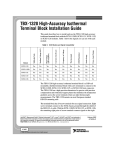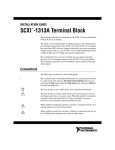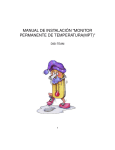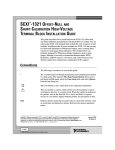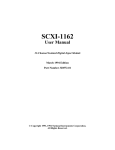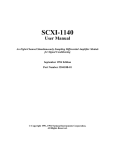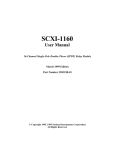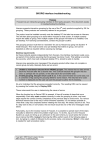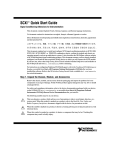Download SCXI-1300/1301 Terminal Block Installation Guide
Transcript
INSTALLATION GUIDE SCXI™-1300/1301 TERMINAL BLOCK This guide describes how to install and use the SCXI-1300 and SCXI-1301 terminal block with your SCXI module. Introduction The following sections describe the SCXI-1300/1301 terminal blocks and their associated screw terminals. SCXI-1300 Using the SCXI-1300 terminal block with 32-channel SCXI modules, you can conveniently connect signals through screw terminals. Your terminal block has the following features: • Seventy-two screw terminals • A cold-junction temperature sensor • Thirty-two pairs of screw terminals that connect to the 32 differential inputs of the SCXI module • Two screw terminals that connect to the module functional chassis ground pins • A solder lug available as a safety chassis ground • Additional screw terminals connect to the SCXI module OUTPUT, the SCXI module AOREF, and to the SCXIbus GUARD SCXI-1301 Using the SCXI-1301 terminal block, which has 20 screw terminals, you can conveniently connect signals to the SCXI-1140 module. Your terminal block has the following features: • Eight pairs of screw terminals connect to the eight differential inputs of the SCXI-1140 module • Two screw terminals that connect to the AGND of the module • Additional screw terminals that connect to the HOLD signal and functional chassis ground LabVIEW ™, National Instruments™, ni.com™, and SCXI™ are trademarks of National Instruments Corporation. Product and company names mentioned herein are trademarks or trade names of their respective companies. 322715A-01 © Copyright 2000 National Instruments Corp. All rights reserved. May 2000 What You Need to Get Started To set up and use your SCXI-1300/1301 terminal block, you need the following items: ❑ SCXI-1300 or SCXI-1301 terminal block ❑ SCXI-1300/1301 Terminal Block Installation Guide ❑ SCXI chassis ❑ SCXI module ❑ Your SCXI module user manual ❑ Number 1 and 2 Phillips-head screwdrivers ❑ 1/8 in. flathead screwdriver ❑ Long-nose pliers ❑ Wire cutter ❑ Wire insulation stripper SCXI-1300/1301 Terminal Block 2 www.ni.com Connecting Signal Wires to the Terminal Block Connect signal wires to the terminal block using the following procedure, referring to Figures 1, 2, and 3 as necessary: 1. Unscrew the top cover screws and remove the top cover. 2. Loosen the strain-relief screws and remove the strain-relief bar. 2 6 7 3 1 4 5 Back View 1 2 Strain-Relief Bar Strain-Relief Screws 3 Front View Earth-Ground Solder Lug 4 5 Mating Connector Thumbscrew 6 7 Top Cover Screws Top Cover Figure 1. SCXI-1300/1301 Parts Locator Diagram 3. Run the signal wires through the strain-relief opening. You can add insulation or padding if necessary. 4. Prepare your signal wire by stripping the insulation to no more than 7 mm. 5. Connect the signal wires to the screw terminals by inserting the stripped end of the wire fully into the terminals and tighten the screws with a flathead screwdriver. Tighten the screws to a torque of 5 to 7 in.-lb. Uninsulated wire extending past the screw terminal increases the risk of short circuiting adjacent signals, causing the circuit to fail. Caution © National Instruments Corporation 3 SCXI-1300/1301 Terminal Block 6. Reinstall the strain-relief bar and tighten the strain-relief screws. 7. Reinstall the top cover and tighten the top cover screws. When connecting signals to the SCXI-1300 terminal block, follow the labeling on the SCXI-1300 terminal block, as indicated in Figure 2. 1 2 1 Screw Terminals 2 Mating Connector Figure 2. SCXI-1300 Signal Connections SCXI-1300/1301 Terminal Block 4 www.ni.com When connecting signals to the SCXI-1301 terminal block, follow the labeling on the SCXI-1301 terminal block, as indicated in Figure 3. 1 2 1 Screw Terminals 2 Mating Connector Figure 3. SCXI-1301 Signal Connections You are ready to connect the terminal block to the module front connector as explained in the Connecting the Terminal Block to the SCXI Module section. © National Instruments Corporation 5 SCXI-1300/1301 Terminal Block Connecting the Terminal Block to the SCXI Module To connect the terminal block to the SCXI module front connector, perform the following steps: 1. Connect the SCXI-1300/1301 terminal block to the mating connector on the module front connector. 2. Tighten the top and bottom thumbscrews on the back of the terminal block to hold it securely in place. In Using the SCXI-1300 with Thermocouples This section describes how to use the thermocouple capability of your SCXI-1300 terminal block. Connecting Thermocouples ♦ SCXI-1100 If you are using a ground-referenced thermocouple, connect the thermocouple positive and negative leads to CH+ and CH– respectively. Leave jumper W1 on the SCXI-1100 in the factory-default (parking) position. If you are using a non-referenced (floating) thermocouple, the SCXI-1100 instrumentation amplifier can be driven into saturation if the thermocouple is not grounded properly. Choose one of the following two options to ground the thermocouple: • Ground the negative lead of the thermocouple near the thermocouple junction. Leave jumper W1 on the SCXI-1100 in the factory-default (parking) position. • Ground the negative lead of the thermocouple inside the SCXI-1300 terminal block, by connecting CH– to CHSGND as shown in Figure 4. In most applications, this is the most convenient grounding option. Leave jumper W1 on the SCXI-1100 in the factory-default (parking) position. Note National Instruments does not recommend setting jumper W1 on the SCXI-1100 in the non-parking position. This grounds the negative terminal on the SCXI-1100 instrumentation amplifier through a 100 kΩ resistor, possibly increasing measurement noise and settling time. SCXI-1300/1301 Terminal Block 6 www.ni.com 1 3 2 1 Channel 0 2 Chassis Ground 3 Thermocouple Figure 4. Connecting a Thermocouple to SCXI-1300 Channel 0 © National Instruments Corporation 7 SCXI-1300/1301 Terminal Block ♦ SCXI-1102/B/C If you are using a ground-referenced thermocouple, connect the thermocouple positive and negative leads to CH+ and CH– respectively. If you are using a non-referenced (floating) thermocouple, choose one of the two options to ground the thermocouple: • Ground the negative lead of the thermocouple near the thermocouple junction. • Ground the negative lead of the thermocouple inside the SCXI-1300 terminal block, by connecting CH– to CHSGND as shown in Figure 4. In most applications, this is the most convenient grounding option. Caution Do not reference the thermocouple to ground at more than one point to avoid measurement errors caused by ground loops. Converting the Temperature Sensor Output Voltage to Temperature The integrated-circuit temperature sensor outputs 10 mV/°C. If your application software does not provide voltage-to-temperature conversion for the cold-junction reference (CJR) of the SCXI-1300, you can determine the CJR temperature using the following formulas: T ( °C ) = 100 ( V TEMPOUT ) [T( ° C ) ]9 T ( °F ) = ----------------------- + 32 5 where VTEMPOUT is the temperature sensor output voltage, and T(°F) and T(°C) are the temperature readings in degrees Fahrenheit and degrees Celsius, respectively. Note Average a large number of samples to obtain the most accurate reading. Reading the Temperature Sensor in LabVIEW In LabVIEW, the channel address string used to read VTEMPOUT depends on which module is connected to the SCXI-1300. For more information about channel-string arrays and the SCXI channel-addressing syntax, see the LabVIEW Data Acquisition Basics Manual. ♦ SCXI-1100—use obx ! scy ! mdz ! mtemp. This channel-address string cannot be in a channel-string array with other channels on the same SCXI-1100 module. ♦ SCXI-1102/B/C—use obx ! scy ! mdz ! mtemp. This channel-address string can be in the same channel-string array as other channels on the same SCXI-1300/1301 Terminal Block 8 www.ni.com SCXI-1102/B/C module, but it must be the first element in the channel-string array. ♦ SCXI-1104/C—not applicable. Since the SCXI-1104/C is unsuitable for use with thermocouples, VTEMPOUT is not routed through the module. Cleaning the Terminal Block To remove light dust, use a soft, nonmetallic brush. To remove other contaminants, use deionized water and a stiff nonmetallic brush. The unit must be completely dry and free from contanimants before returning to service. Specifications All specifications are typical at 25 °C unless otherwise specified. Electrical (Cold-Junction Sensor on the SCXI-1300) Sensor type............................................. Integrated circuit (LM35CAZ) Accuracy1 ............................................... ± 1.3 °C from 0 to 50 °C Repeatability .......................................... ± 0.5 °C Output..................................................... 0 to 0.5 V from 0 to 50 °C (10 mV/°C) Environment Operating temperature............................ 0 to 50 °C Storage temperature ............................... –20 to 70 °C Relative humidity ................................... 10 to 90% Indoor use only 1 This includes the accuracy of the temperature sensor itself (± 0.9 °C) and the temperature difference between the temperature sensor and any screw terminal (which may be as large as ± 0.4 °C ). © National Instruments Corporation 9 SCXI-1300/1301 Terminal Block










